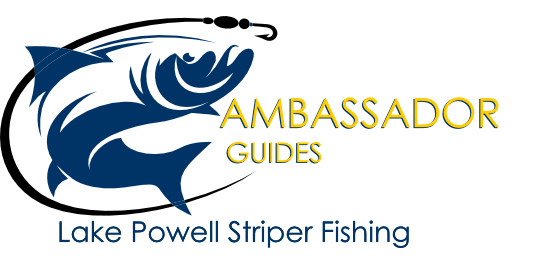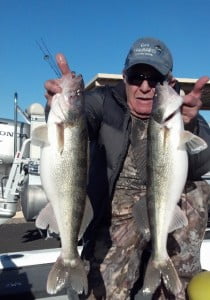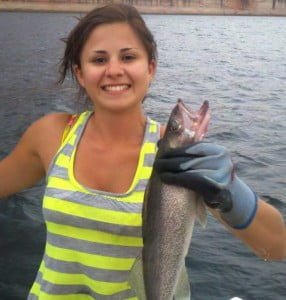5lb Walleyes – Lake Powell
Lake Powell Fish Report – February 29, 2012 Lake Elevation: 3635 Water Temperature 48-53 F
By: Wayne Gustaveson
Spring Fishing Begins
The water is cold and fish are fussy but some really nice stripers, walleye and bass are being caught. The first fish of spring are fat and healthy. It looks like game fish have wintered well and show signs of producing a bumper crop of trophy individuals in March and April.
If you can’t wait for warmer weather and need a trip to Lake Powell, here is the pattern for success. Most fish are holding in the back of canyons where water depth is 25 feet. The forest of trees submerged by the huge spring flood from last year is still under water. Bait fish and predators are all in the same location. Most are slow moving and happy to stay wrapped in the tree limbs they have occupied all winter. But all will eat for a short time each day when a tiny bluegill, shad, or lure invades their brushy living room.
Stripers are loosely associated with brush as they have become accustomed to chasing food in and around the tree branches. Stripers will now respond to lures trolled over and through the trees. For best results, troll in a circular or zigzag pattern where bottom depth is 25 feet. Try to bring lures close to big trees without dragging them into unforgiving snags. Lures that dive to 8-12 feet may be the best while trolling the brush line. Resting stripers will seek deeper water and may respond to deep diving lures, but shallower fish seem easier to catch, particularly in the afternoon as water warms slightly. When spooning along the bottom in obvious schools seen on the graph it may be necessary to hold the bait still for a minute or two before stripers will respond. Mark the resting school and try a variety of lures and techniques to get a feeding reaction going. Usually slow and slower dead-sticking are the best techniques.
Stripers are curious and respond to feeding actions of their school mates. A hooked fish is often trailed by interested onlookers. Take advantage of this behavior by jigging spoons or casting lures to the general area of the hooked fish. Let the lucky angler net his own fish while others in the boat try to duplicate that success and keep the flighty school under the boat for maximum hookups.
Bass and walleye are in the same general vicinity. If trolling is not working, park the boat in 25 feet of water and cast to the brushy shoreline where water depth is 8 feet. Shallow flats do not hold as many fish as the trough between two points. Run a swimbait slowly along the bottom from 8 to 25 feet. Bump bottom occasionally and fish slowly. Sometimes bass will be hugging bottom while at other times they will be suspended in the trees. Suspending jerkbaits, like Lucky Craft Pointers, can be retrieved very slowly with long pauses to interest bass and walleye suspended in the trees. In this cold water try slowing down until dormant fish begin to react.
Crappie are holding in the thickest trees where bottom depth is 12 feet. Fish small (1/16th ounce) plastic or marabou jigs straight up and down to attract fish and prevent snags. Again, crappie like slow steady moving lures better than fast moving objects. All of these fish have been caught well at times during February. March will be even better on good weather days.





